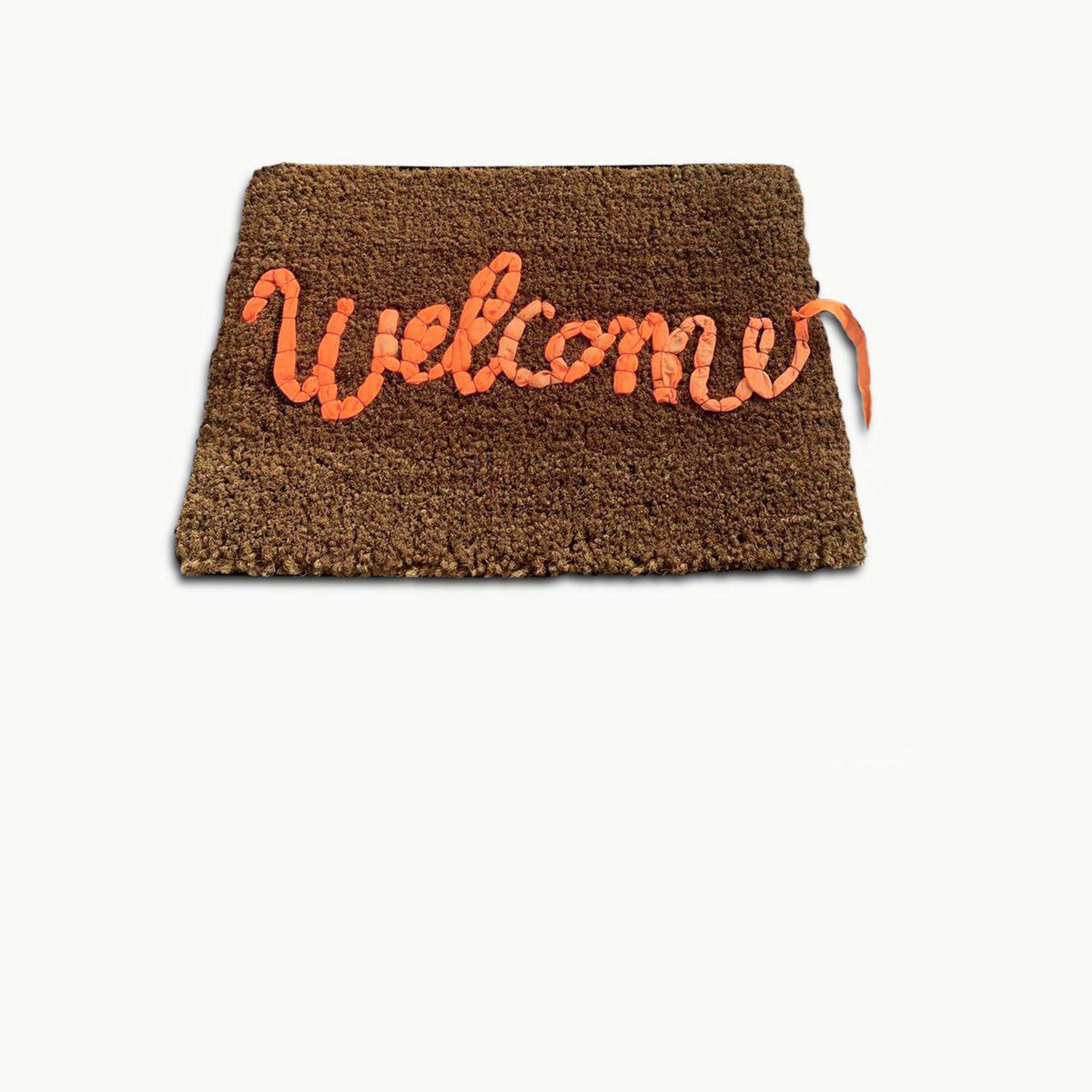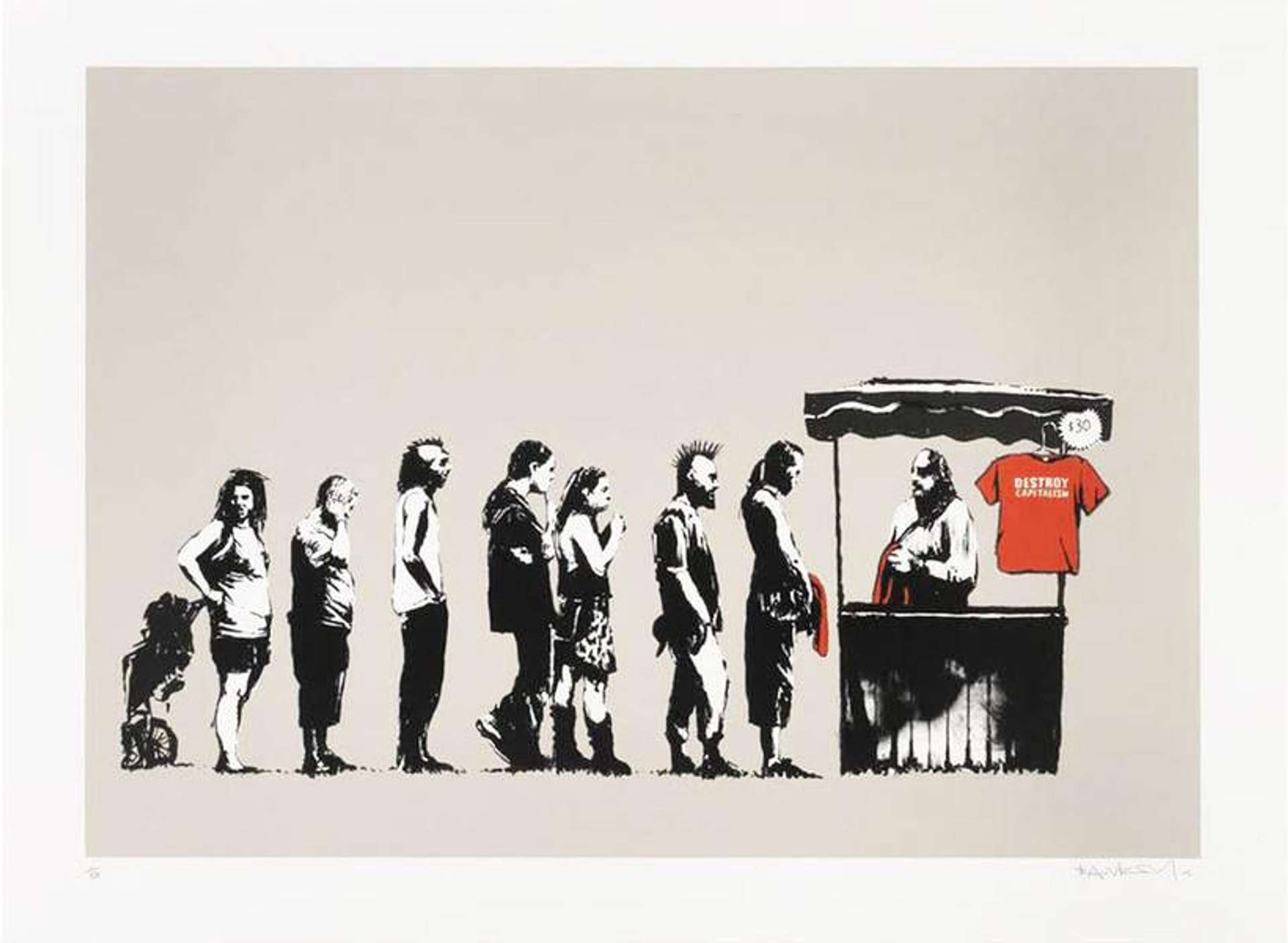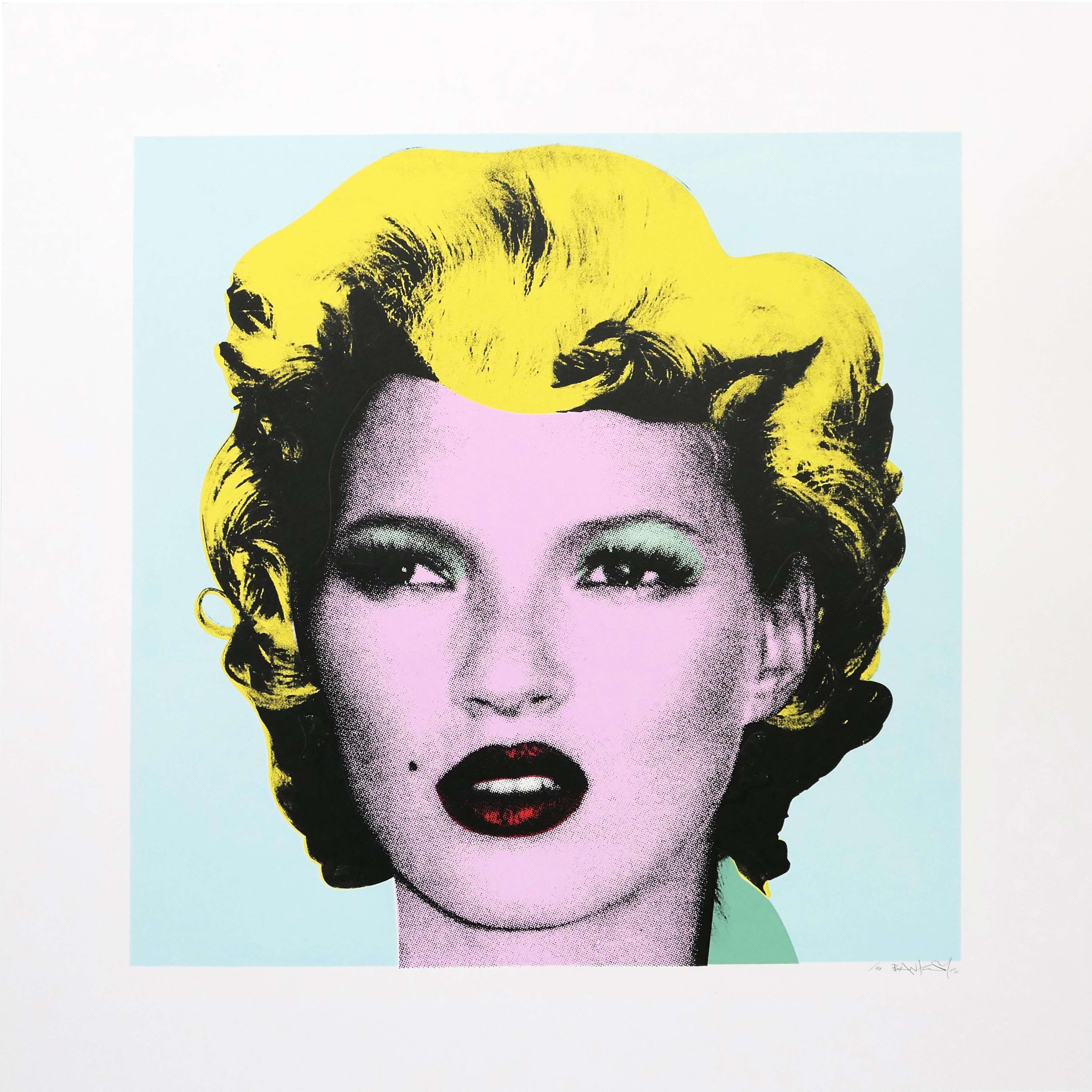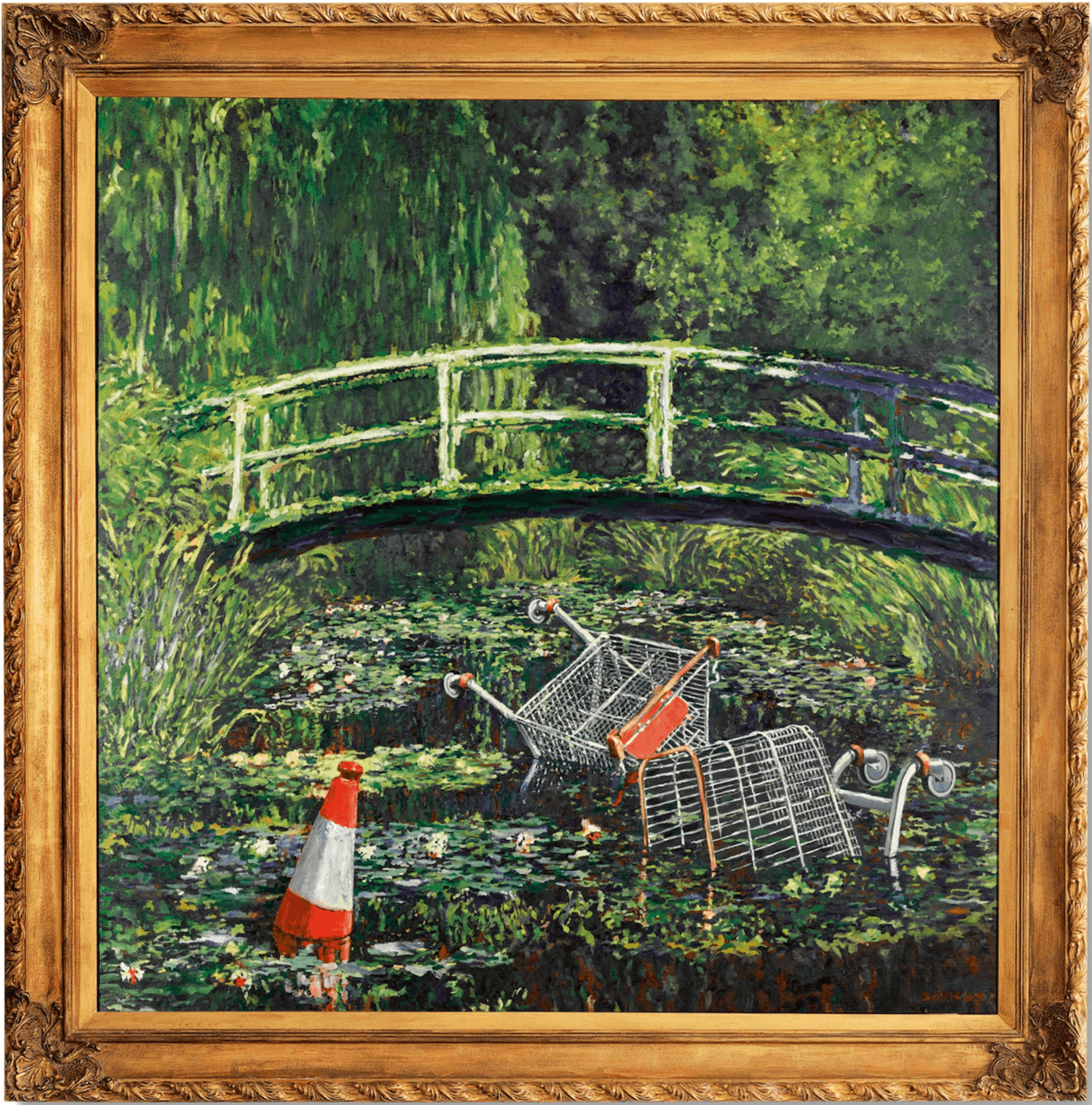 Show Me The Monet ⓒ Banksy, 2005
Show Me The Monet ⓒ Banksy, 2005
Banksy
269 works
Held in London in 2005, Bristol-born Banksy’s Crude Oils exhibition catapulted the Street Art legend towards international stardom. Officially subtitled "Gallery of re-mixed masterpieces, vandalism and vermin", it will come as no surprise to Banksy fans that the exhibition did exactly what it said on the tin, and then some...
Featuring some of his most famous – and most expensive – works, this subversive gallery show, held in a small shop in Westbourne Grove, cemented the faceless maverick as a major player in the contemporary art scene.
It also marked Bansky’s entry into the commercial art market: half of the 22 artworks shown at the exhibit had been sold before it even opened.
In this article, we take a closer look at Crude Oils - Banksy’s career-making London gallery show – and some of the key works that defined it.
Off the Streets and Into a New Setting: Banksy's First Exhibitions
In 2000, Banksy began to move his artworks from the street to a new setting: the gallery.
In the same year, the artist held his first-ever solo exhibition at Severnshed – a restaurant in Bristol harbour located right next door to the infamous Thekla – a boat-come-venue that would go on to be adorned with the iconic Banksy mural, The Grim Reaper (2005).
This small-scale exhibition was followed up by another show, Existencilism (2002), which was to be Banksy’s first ever in the United States. This gallery show featured iconic works such as Barcode, Queen Victoria, Love Is In The Air and Laugh Now.
In 2003, Banksy held his ‘Turf War’ exhibition in London’s East End. This was to prove a decisive moment in his career.
Making headlines for its controversial use of live animals, the exhibition caused outrage amongst animal rights activists, but otherwise proved a critical success.
It was these animals – as well as the exhibition’s tongue-in-cheek, critical nature – that paved the way for one of the most iconic, groundbreaking and subversive Banksy exhibitions yet: Crude Oils.
Banksy Opens Crude Oils in Notting Hill (London, 2005)
In October 2005, Banksy unveiled the Crude Oils exhibition. The exhibition spanned the course of just a week, between 22nd-24th October, and was hosted in the interior of a small shop at 100 Westbourne Grove in London’s Notting Hill.
What made the exhibition so unique? It was the first major confrontation between the street art legend and the art historical canon.
Crude Oils took place just a few months after the artist embarked on his first major trip to Palestine, where he famously painted nine artworks, including Love Is In The Air or Flower Thrower, Cut It Out and The Segregation Wall, both on and around the West Bank Wall.
The most distinctive – and possibly hazardous – feature of the exhibition? The gallery space was occupied by 200 live black rats.
Why rats? Well, Banksy explained:
The rats were not without their problems. Steve Lazarides, Banksy’s former gallerist, commented on the many logistical and legal difficulties surrounding the exhibition:
“It took me – I reckon – four months to find a venue that would allow us to have like, two hundred live rats running around in it. We fitted it all out so the rats couldn’t escape; we’d written a waiver form that people had to sign before they came in that said, well, you know, ‘if you get bitten by one of the rats then it’s your own stupid fault’; and then we could only have five people at a time actually in the show. So I had a stopwatch, I’d time them, they’d get two minutes – then they’d have to go.”
In spite of the show's unconventionality, many people still attended; read just one review from the time here, to get a flavour of what the experience was like.
As for the artworks on the walls – these went on to become some of Banksy’s most famous. Over 20 in number, each constituted a reworked version of classic oil paintings by Vettriano, Hopper, Warhol, Monet, and van Gogh.
A Closer Look at Banksy’s Oil Paintings on Show
The exhibition contained some oils on canvas that were wholly painted by Banksy himself, albeit after masterpieces by famous painters, such as Show Me The Monet and Sunflowers From Petrol Station. Alongside these works, which showcased Banksy's technical brilliance in a medium other than spray paint for the first time, were reworkings of canvases Banksy found in flea markets. All of these 'Crude Oils' demonstrated Banksy's knack for subverting a familiar scene, but let's take a look at some of the most prominent works form the show...
 Show Me The Monet ⓒ Banksy, 2005
Show Me The Monet ⓒ Banksy, 2005Show Me The Monet
Show Me The Monet was the stand-out painting of the exhibition.
A dethroning of Monet’s Bridge Over A Pond Of Water Lillies, one of the many paintings the Impressionist artist made of his gardens at Giverny, Normandy, here Banksy sticks two fingers up at the art establishment.
Disrupting the bucolic charm of Monet’s pastoral scene, Bansky adds two symbols of urban disorder and decline: the abandoned shopping trolley and a traffic cone, far from any traffic.
In the gallery room, the painting was accompanied by a ‘dead’ gallery attendant – or uniform-clad skeleton – who sat directly to its right.
In 2020, Show Me The Monet went under the hammer at auction, selling for nearly £7.6 million. It become the second most expensive Banksy work sold at auction at the time. It later emerged that the painting was sold by the same couple who were the only ones brave enough to host Banksy's Crude Oils exhibition initially.
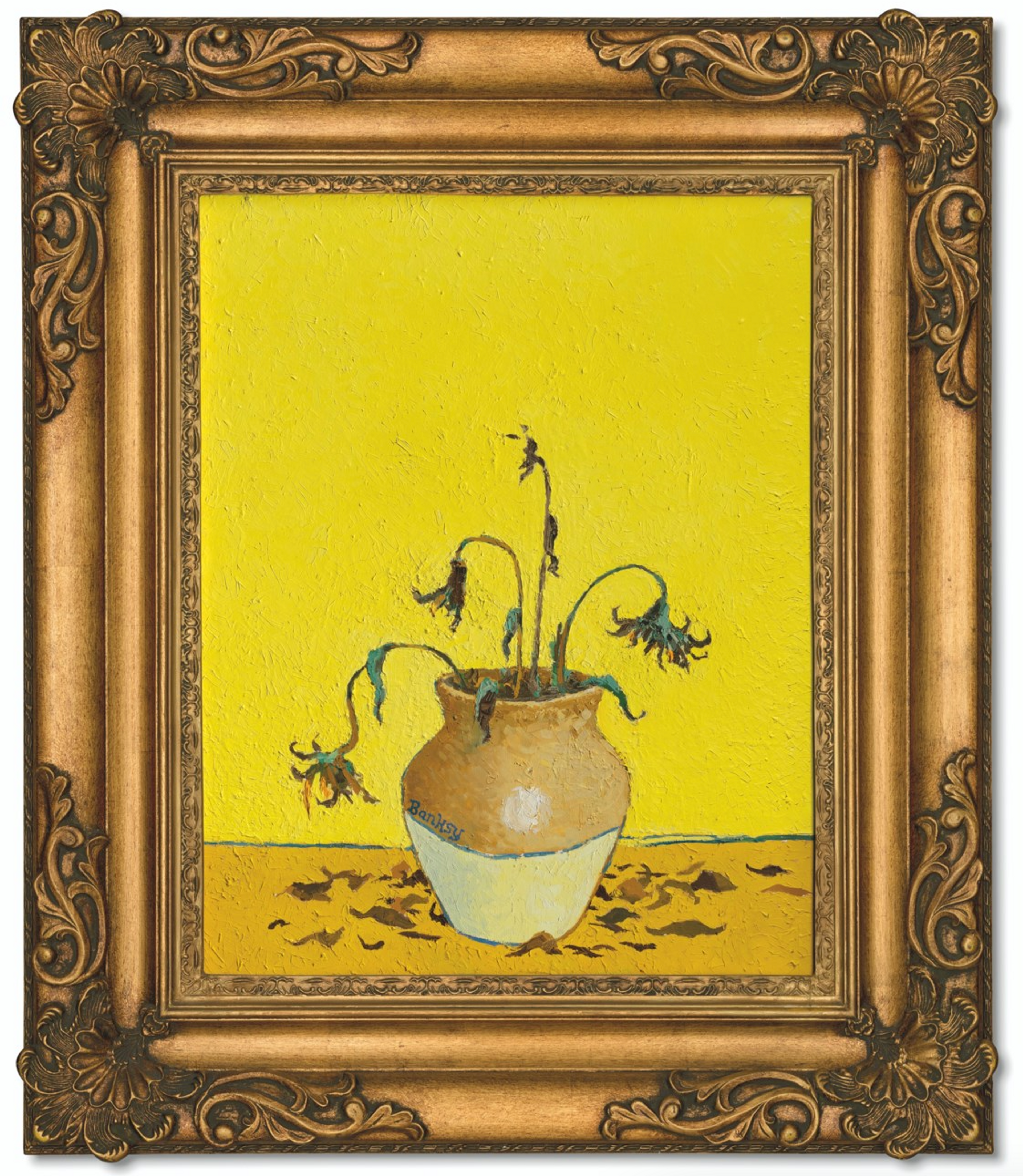 Sunflowers From Petrol Station ⓒ Banksy, 2005
Sunflowers From Petrol Station ⓒ Banksy, 2005Sunflowers From Petrol Station
Among Crude Oil paintings was a piece that went on to become, in 2021, Banksy’s third-most expensive. Its title? Sunflowers From Petrol Station.
Here, Banksy takes Van Gogh’s iconic sunflowers, places them in a hot, sweaty room and forgets to water them.
A depressing sight, the painting evokes a neglected bouquet of flowers, much like those you might find in the forecourt of a petrol station at the end of a hot summer’s day.
Soup Can
Another of Banksy’s subversive iconographies to make its first public appearance as part of the Crude Oils exhibition is Soup Can.
This bold, hard-edged image screams Pop Art. Instantly recognisable and familiar, it re-appropriates Andy Warhol’s iconic Campbell’s Soup can prints, re-styling them for a British audience.
As the story goes, Warhol made his Campbell’s Soup Cans because of their strong associations with American capitalism and consumerism.
In his own reworked version of these classic images, which also features in the Soup Cans (Quad) print series, Banksy turns away from the States, opting in favour of an ubiquitous British brand: the Tesco Value range.
 Monkey Poison ⓒ Banksy, 2005
Monkey Poison ⓒ Banksy, 2005Monkey Poison
Combining Banksy’s fascination for monkeys and the rigid yet awe-inspiring tradition of the Dutch Old Masters, Monkey Poison also appeared at Crude Oils.
The work sees Banksy stencil a petrol-drinking monkey over the top of a reproduction of a village scene, much like those painted by Jan Hendrik Verheijen or Paulus Potter.
Deeply mocking and satirical, the piece poses the viewer a question that Banksy has continued to make throughout his career: do we ‘consume’ art as we would other commodities? and do we do so without really thinking about it?
Kate Moss
Another nod to Warhol, Banksy’s Kate Moss ‘edits’ the American artist’s internationally famous Marilyn Monroe paintings, made during the 1960s and 1970s.
Like the Soup Cans, however, Banksy is sure to relate his artwork to a British audience: replacing Marilyn as the image’s focal point is Croydon-born supermodel and household name, Kate Moss.
Mirroring Warhol’s own practice, Banksy has since painted Moss in a variety of colours, including apricot and gold, blue and grey , pink, dark pink, and purple, producing a large number of Moss prints in the process.
In May 2022, one of Warhol’s original Monroe paintings – Shot Sage Blue Marilyn (1964) – sold for $195 million (£158.17) at Christie’s New York, making it the most expensive piece of 20th-century art ever sold.
 Image © Sotheby's / Crude Oil (Vettriano) © Banksy 2005
Image © Sotheby's / Crude Oil (Vettriano) © Banksy 2005Crude Oil (Vettriano)
Another standout work from Banksy’s Crude Oils series, Crude Oil - Vettriano, subverts Jack Vettriano’s The Singing Butler, transforming the beloved image of a romantic beachside dance into a sharp critique of environmental negligence. In this 2005 oil and spray paint work, Banksy reimagines the scene with two figures in hazmat suits struggling to dispose of an oil barrel nearby - while the elegantly dressed couple continue their waltz, oblivious to the unfolding crisis. The work, first exhibited in Banksy’s Crude Oils show in 2005, is now set to appear at Sotheby’s London Modern & Contemporary Evening Auction on 4 March 2025, carrying an estimate of £3,000,000 - £5,000,000. Offered from the private collection of Blink-182’s Mark Hoppus, this sale adds another layer of cultural significance to the work, bridging street art, celebrity, and environmental activism in one provocative statement.


